Aggregate
Testing Equipment
We are a well known name in manufacturing
testing instruments which are available in
economical prices. These products are well
integrated with various essentials. Following
are the products we are offering under this
category: |
| |
|
| |
|
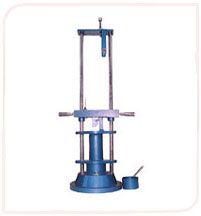 |
KEWIL
Aggregate Impact Tester
We are a reckoning name in manufacturing impact
testers. These are superior in quality and
deliver highly rated performance. We ensure
that these testers are accurate in functioning
and yet cost effective. Following are some
essentials provided along with our equipment:
• Automatic blow counter
• Tamping Rod
• Cylindrical Cup
• Metal Measure 75 mm ID X 50 mm deep
| Characteristics
of Aggregate Impact Tester
|
- The
instrument consists of a circular
base with two vertical guides.
- Provided
with a hammer, which can be raised
to fall freely down the vertical
guides.
- The
hammer is provided with locking
arrangement.
- The
equipment is provided with metal
measures and tamping rod.
|
|
Applications
Aggregate impact tester finds
application in the following industries: |
- Construction
(Roads, Bridges, Dams, Buildings,
etc.)
- Cement
- Ceramics
- Chemicals
- Mining
|
- Irrigation
- Calibration
laboratories/Test houses
- Research
& Development
- Education
- Railways
|
|
| |
| |
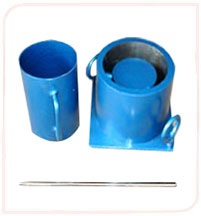 |
KEWIL
Crushing
Value Apparatus
Our aggregate crushing value apparatus are
used for measuring resistance of an aggregate
to crushing. This apparatus is extensively
used for various industrial applications.
The
equipment consists of a steel cylinder Provided
with a base plate, a plunger handle and
a tamping rod.
One end of the tamping rod is rounded.The
surfaces coming into contact with the aggregate
are case hardened.
Sizes
Available:
1.75mm dia
2.150mm dia
3.200mm dia |
| |
| |
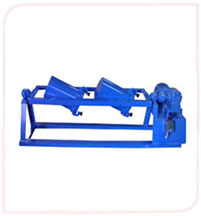 |
KEWIL
Devel Abrasion Machine
For resistance of aggregate that is caused
by wear two hollow cylinders are attached.
These cylinders are closed at one end and
are provided with tight fitted covers at the
other end. The inside diameter of the cylinder
is of 20cms and 34cms depth. These cylinders
are mounted on a shaft at an angle of 30 degrees
with the axis of rotation. The shaft rotates
at 30-33 r.p.m through a reduction gear, coupled
to a motor.
Suitable for operation on Three phase AC Supply
with 440 volts & 50 cycles. The m/c is
fitted with a push button and counter starter
for easy user interface. Complete with abrasive
charge the machine consists of 12 cast iron
spheres of steel spares. The spares are steel
balls that are hardened & are of approximately
48mm dia meter, each weighing between 390-445
gram. |
| |
| |
|
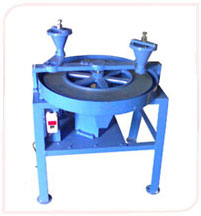 |
KEWIL
Dorry Abrasion Testing Machine : BS : 812
This machine is used for determining the resistance
of aggregate to wear by abrasion. Two specimen
can be mounted simultaneously and then kept
loaded by weights against a machined flat
circular grinding surface. The grinding disc
rotates at 28-30 r.p.m and two funnels release
a continueous flow of Suitable sand for operation
on 230 Volts, Single phase 50 Cycles A.C.
Supply.
Optional:
Digital Timer.
|
| |
| |
|
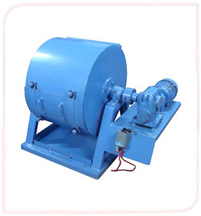 |
KEWIL
Los Angeles Abrasion Machine
The important features and specification of
Los Angelesabrasion testing machine are :
The machine comprises of a hollow cylinder,
which is horizontally mounted on a strong
frame on ball bearings. The cylinder has an
opening, which can be closed with a dust tight
cover to promote charging and discharging
the cylinder with the material under test.
It consists of a detachable extension that
extends throughout the interior of the cylinder
and prevents it from falling on the cover.
The cylinder is rotated by an electric motor
through a heavy reduction gear. A revolution
counter is attached to the frame and provided
with tray for collection of materials at the
end of the test. The machine is supplied with
abrasive charges consisting of a set of 12
hardened steel balls having approximately
48 mm diameter.
Optional: Digital Timer. |
| |
| |
|
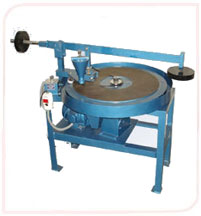 |
KEWIL
Tile Abrasion Testing Machine
IS : 1237-1980, IS : 1706 - 1972
It is used for determining the resistance
of flooring tiles to wear or abrasion.
It consists of the following :-
i) A grinding disc furnished with a replaceable
grinding path and rotating horizontally about
its vertical axis.
ii) A circular tray enclosingthe grindingdisc.
iii) Holding device for test specimen.
iv) Reduction gear coupled to a motor for
operation on 220 v, 50 Hz, single phase supply.
v) Revolution counter. (Preset cumulative).
vi) A 7.5 kg weight to apply 30 kg load on
specimen through lever.
ACCESSORIES
:
Thickness Measurement Jig with 0.01 mm x
25 mm dial gauge.
|
| |
| |
|
 |
KEWIL
Cylindrical measures
Cylindrical measures are used to determine
unit weight of concrete or fine, coarse and
mixed aggregates, as well as for void content
of aggregates. These measures are immune to
cement paste and can also be used for unit
weight and yield of fresh concrete. It also
indicates the angularity, spherical nature
and workability of fine aggregate in a mixture.
Materials used
to make Cylindrical Measures
These are usually made of heavy duty materials
to withstand rough usage.
They are generally made up of :
• Sheet Iron
• Aluminium
• Steel
• Metal
|
Salient
Features
Some important features are :
|
- Cylindrical
measures are calibrated and provided
with handles.
- Consists
of three measures, one each of 3
litres capacity, 15 litres capacity
and 30 litres capacity.
- Provided
with a tamping rod which has 16
mm dia and is 600 mm long. One of
the ends of the rod is rounded.
- These
are watertight with top and bottom
true and even.
- Steel
units are seam welded with bail
handles; aluminum ones are machined
to accurate dimensions and have
integral cast handles.
|
Applications
There are mainly used for determining
unit weight of concrete or aggregates.
Some of the areas where they find application
are: |
- Testing
crushed rock
- Cement
& concrete industry
- Testing
of crushed slag & crushed and
uncrushed gravel
- Construction
(Buildings, Roadways, etc.)
|
|
| |
| |
|
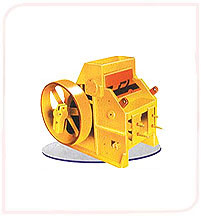 |
KEWIL
Jaw crushers
Jaw crushers are primary crushers used for
the processing of hard feedstocks, such as
rock and concrete. This is made possible with
the help of a pair of vertical jaws lined
with replaceable manganese steel plates. One
jaw is fixed and the other moves back and
forth.
Salient Features
The important features are:
- The
crusher is made of cast steel.
- The
jaws of the crusher are made of manganese
steel.
- The
opening of the jaws is adjustable from
20 mm to 6 mm and its capacity is 200
kilograms per hour.
- The
crusher is provided with a hopper at the
top for pouring materials.
- The
equipment is supplied with 3 HP electric
motor, triple V-belt pulley type and mounting
frame.
Components
The various components of jaw crusher are
:
- Crusher
Frame
- Jaw
Stock
- Pitman
- Eccentric
Shaft
- Anti-friction
Bearings
- Crushing
Jaws
- Wedge
Setting Block
- Toggle
Plates
- Side
Plates
- Fly
Wheels
- Draw
Back Strings & Fittings
Working Principle of
Jaw Crusher
The working principle of these crusher is
based on modern design, that is, "crushing
without rubbing."
The equipment consists of two Jaws, one is
fixed and the other moves back and forth.
The jaws are positioned in such a way that
there is a wide opening at the top, known
as the gape, and a narrow discharge aperture
at the bottom, set to the desired output size.
The pitman lever moving on an eccentric shaft
on bearing suspend the moving jaw on the center
pin. The material held in between the two
jaws are crushed by mechanical pressure.
Applications
There are very useful in aggregate industries
for crushing rocks and stones. Some of the
areas where they are commonly used are :
• Building Construction
• Roadways Construction
• Aggregate Production
• Concrete Preparation
|
| |
| |
|
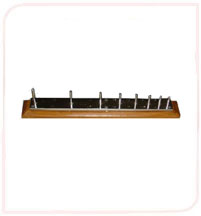 |
KEWIL
Length gauge
Length gauge is used to measure sample sizes
of aggregates, sand and fillers.
Salient Features
- The
instrument consists of a steel plate on
which eight steel pins are vertically
mounted with specified distance in between.
- It
consists of a hard wood base with vertically
mounted metal studs.
Working
Principle of Length Gauge
- Particle
is elongated when its length is more than
1.8 mm of the midsize of the sieve fraction.
- Aggregate,
which has to be classified is parted into
7 sieve fractions from 63 to 6.3 mm and
each part is examined separately.
- There
are 6 labeled opening between pairs of
metal pins. These pins measure particle
from each of the 6 sieve cut below 50
mm.
Elongation
index is the mass of elongated particles failing
to pass between pins as percent of the sample.
Applications
It is an instrument used to measure sample
sizes of aggregates, sand and fillers. Some
of the application area of length gauge are
:
- Soil
Analysis
-
Cement & Concrete Industry
- Rock
& Aggregate Testing
- Ceramic
Industry
- Research
& Development
|
| |
| |
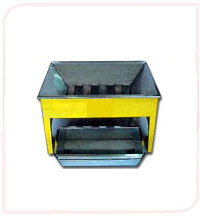 |
KEWIL
Riffle sample dividers
Riffle sample dividers are used for the easy
dividing and reduction of bulk material samples
with particle sizes ranging from less than
1 mm up to a maximum of 10 mm. This equipment
is mainly used for sampling aggregates, cement,
ores, refractory materials, pigments, soap,
powdered coal etc. It is also used for rapid
collection of true representative sample from
aggregates, sand and fillers.
Salient Features
The salient features of riffle sample divider
are :
- The
equipment is made up of sheet metal and
consists of a metal box mounted on legs.
- It
is fitted with a series of channels or
slots of equal width that discharge the
material alternatively in opposite directions
into separate pans.
- The
slots of the riffle are steep enough to
allow rapid flowing of the material.
- The
Equipment has 14 numbers of slots of 13
mm width and is supplied with two receivers.
Applications
Riffle dividers find application in many areas.
Some of its application areas are :
- Rock
& Aggregate Industry
- Cement
Industry
- Mining
- Construction
(Roads, Bridges, Buildings, Dams etc.)
- Ceramics
Industry
|
| |
| |
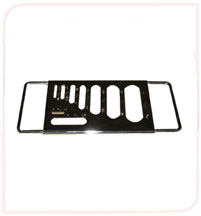 |
KEWIL
Thickness Gauge
Thickness Gauge, also known as Flakiness Index
is an instrument used to select samples from
aggregates, sand and fillers. They can also
be used to determine the flakiness index of
aggregates.
Salient Features
- The
instrument consists of a frame with a sliding
panel.
- The
slot comprises of properly cut standard
slots of different length and width.
- They
are usually made of steel with chromium
coating.
Working
Principle of Thickness Gauge:
- A
particle is said to be flaky when its thickness
is less than 0.6 of the mid-size of the
sieve fraction.
- This
type of gauge has 7 labeled slots for rapid
hand trying of particles from each of the
slots.
- Flakiness
index refers to the mass of all flaky particles,
passing appropriate slots, as percent of
the sample.
Applications
Thickness gauge finds application in following
areas :
- Cement
& Concrete Industry
- Soil
Study
- Rock
& Aggregates Industry
- Ceramic
Industry
- Research
& Development
|
| |